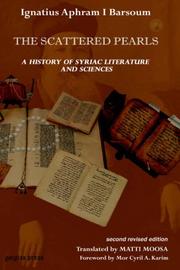| Listing 1 - 10 of 535 | << page >> |
Sort by
|
Book
Year: 1961 Publisher: Paris : Presses universitaires de France,
Abstract | Keywords | Export | Availability | Bookmark
 Loading...
Loading...Choose an application
- Reference Manager
- EndNote
- RefWorks (Direct export to RefWorks)
Book
Year: 1962 Publisher: Basel : Bärenreiter,
Abstract | Keywords | Export | Availability | Bookmark
 Loading...
Loading...Choose an application
- Reference Manager
- EndNote
- RefWorks (Direct export to RefWorks)
Book
ISBN: 1463211686 1593334451 Publisher: Gorgias Press
Abstract | Keywords | Export | Availability | Bookmark
 Loading...
Loading...Choose an application
- Reference Manager
- EndNote
- RefWorks (Direct export to RefWorks)
Jacob of Sarug (451–521) was a prolific writer of the Syriac Church and was known as “the flute of the Holy Spirit and the harp of the believing church”. Sebastian Brock gives the Syriac edition of six homilies written by Jacob: on the birth of our Lord; on the baptism of our Lord; on the Great Lent; on Palm Sunday; on Good Friday; on Easter Sunday. The text is based on an ancient manuscripts preserved in London and dated 609.

ISBN: 1463207751 1931956049 Publisher: Gorgias Press
Abstract | Keywords | Export | Availability | Bookmark
 Loading...
Loading...Choose an application
- Reference Manager
- EndNote
- RefWorks (Direct export to RefWorks)
The only history of Syriac literature to make use of hundreds of manuscripts from the east.
Book
ISBN: 2503611184 9782503611181 Year: 2023 Publisher: Turnhout Brepols
Abstract | Keywords | Export | Availability | Bookmark
 Loading...
Loading...Choose an application
- Reference Manager
- EndNote
- RefWorks (Direct export to RefWorks)
L’anaphore qui porte le nom de Basile († 379) est transmise dans toutes les langues de l’Orient chrétien. Pour la première fois, nous présentons ici l’édition critique du texte syriaque à partir des manuscrits, avec traduction allemande. Elle est précédée par une introduction qui discute de manière détaillée la question des sources et la complexité de l’évolution textuelle.
Book
ISBN: 9781611432374 1611432375 1463230877 Publisher: Gorgias Press
Abstract | Keywords | Export | Availability | Bookmark
 Loading...
Loading...Choose an application
- Reference Manager
- EndNote
- RefWorks (Direct export to RefWorks)
Book
Abstract | Keywords | Export | Availability | Bookmark
 Loading...
Loading...Choose an application
- Reference Manager
- EndNote
- RefWorks (Direct export to RefWorks)
Incarnation. --- Syrian Orthodox Church --- Syrian Orthodox Church. --- Controversial literature.
Dissertation
Year: 1903 Publisher: Berlin : Ebering,
Abstract | Keywords | Export | Availability | Bookmark
 Loading...
Loading...Choose an application
- Reference Manager
- EndNote
- RefWorks (Direct export to RefWorks)
Ignatius VII, --- Syrian Orthodox Church --- Syrian Orthodox Church. --- Controversial literature.
Book
ISBN: 9781593338435 1593338430 Year: 2009 Publisher: Piscataway, NJ Gorgias press
Abstract | Keywords | Export | Availability | Bookmark
 Loading...
Loading...Choose an application
- Reference Manager
- EndNote
- RefWorks (Direct export to RefWorks)
John became bishop of Tella in 519, but left for exile only two years later when Justin I enforced the Council of Chalcedon which Syrian Orthodox Christians refused to accept. John became one of Justinian’s most dangerous ecclesiastical opponents by ordaining thousands of deacons and priests who formed the first generation of the Syrian Orthodox hierarchy. In the present text John lays out his faith in a way which gives an inside view of how a non-Chalcedonian bishop of the sixth century located himself and his co-religionists within the Christian tradition and how he understood the foundation of the Church.
Book
Year: 1975 Publisher: Leighton Buzzard The Faith Press
Abstract | Keywords | Export | Availability | Bookmark
 Loading...
Loading...Choose an application
- Reference Manager
- EndNote
- RefWorks (Direct export to RefWorks)
| Listing 1 - 10 of 535 | << page >> |
Sort by
|

 Search
Search Feedback
Feedback About UniCat
About UniCat  Help
Help News
News